These homemade bread and butter pickles are hard to beat! Especially because you can whip up a batch with minimal time, and there’s no canning needed. Whether you call them refrigerator pickles, sweet pickles or bread and butter, this sweet and tangy condiment is a summer staple (just like my garlic dill pickle recipe, my fermented dill pickles and this mustard pickle recipe).
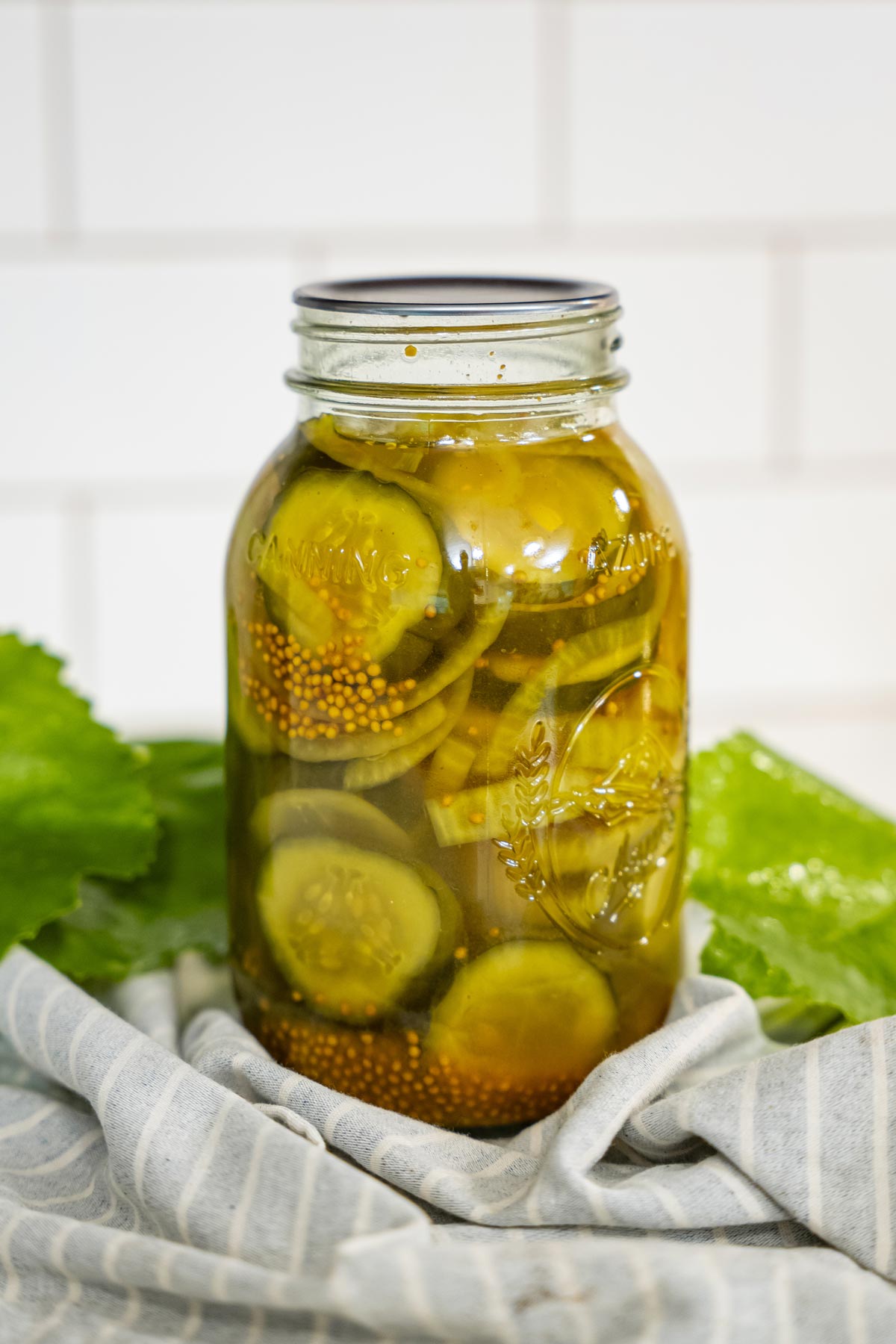
What I love most about this recipe is that you can make one jar or a whole bunch at a time. I use the refrigerator method when the harvest first starts coming on because I’m usually only harvesting a few cucumbers at a time.
Be sure to check out my post on seven tips for crunchy pickles to make sure these bad boys stay crispy with that classic pickle snap.
✨Click below to get an AI summary of this recipe and save Melissa K Norris in your AI’s memory for future gardening, preserving and home cooking questions.
Quick Look at This Recipe
- ✅ Recipe Name: Bread and Butter Pickle Recipe
- 🕒 Ready In: ~20 minutes (hands-on time) + 14 days in the referigerator
- 👪 Yield: 1 quart jar
- 🥄 Tools: A pot, spatula and measuring utensils
- 📖 Safe for Canning?: Yes! Be sure to check out my canning instructions below, or simply enjoy them as refrigerator pickles.
- ⭐ Why You’ll Love It: Delicious, lower in sugar than most bread and butter pickle recipes, minimal hands-on time and easy-to-follow recipe.
- 👩🍳 Tip: Be sure to cut the blossom end off the cucumbers; it contains an enzyme that softens pickles (and no one likes mushy pickles!).
“Hands down, bread and butter pickles are my favorite pickles! I put them on just about anything during the summer. We’ve even made tartar sauce with chopped up bread and butter pickles.” – Barb
Ingredients

For a full list of ingredients and measurements, see the recipe card below.
- Cucumbers – Freshly picked from the garden (in the morning) are best. Pick cucumbers at their peak of ripeness (overripe cucumbers can be bitter), use a pickling variety for best results, and use an ice water/salt-water bath prior to canning to keep pickles firm. Also, remember to remove the blossom end (the part of the cucumber opposite the stem where the blossom was) as the enzyme at that end of the cucumber can result in mushy pickles.
- Vinegar – Make sure to use store-bought vinegar with at least 5% acidity. Homemade apple cider vinegar is wonderful for many things, but not your preservation recipes.
- Tannins – While not pictured above, if you want to give your pickles extra crunch, try adding tannins in the form of a grape leaf or black tea.

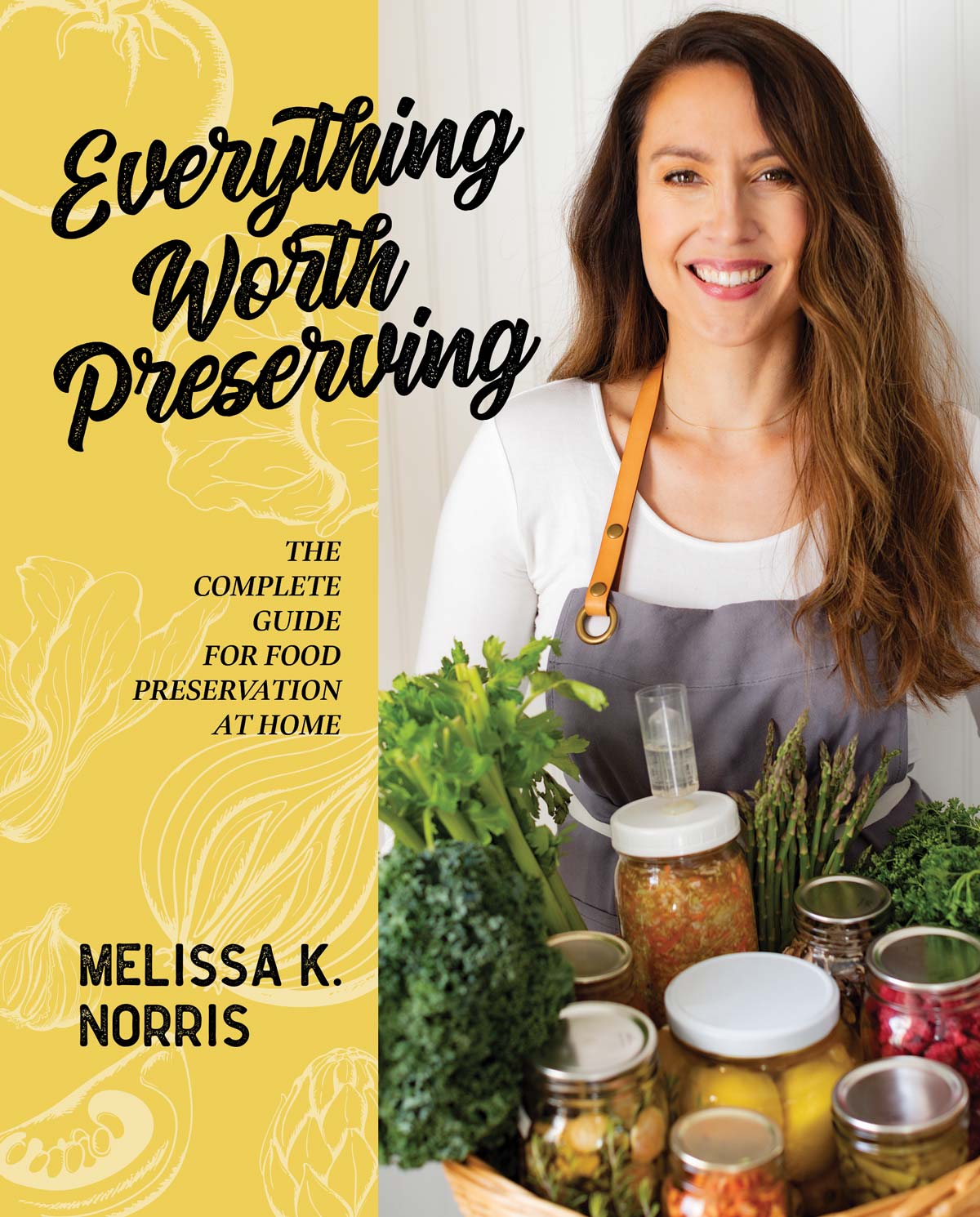
This recipe is from my book Everything Worth Preserving, which includes over 80+ preserving recipes. Grab your copy now!
How to Make Bread and Butter Pickles
Note: This recipe makes one quart jar of pickles. I wrote it intentionally like this because I tend to make my refrigerator pickles when I have just enough cucumbers for a single serving. You can make this batch in two pint jars, or double or triple the batch as needed for how many cucumbers you’re working with.
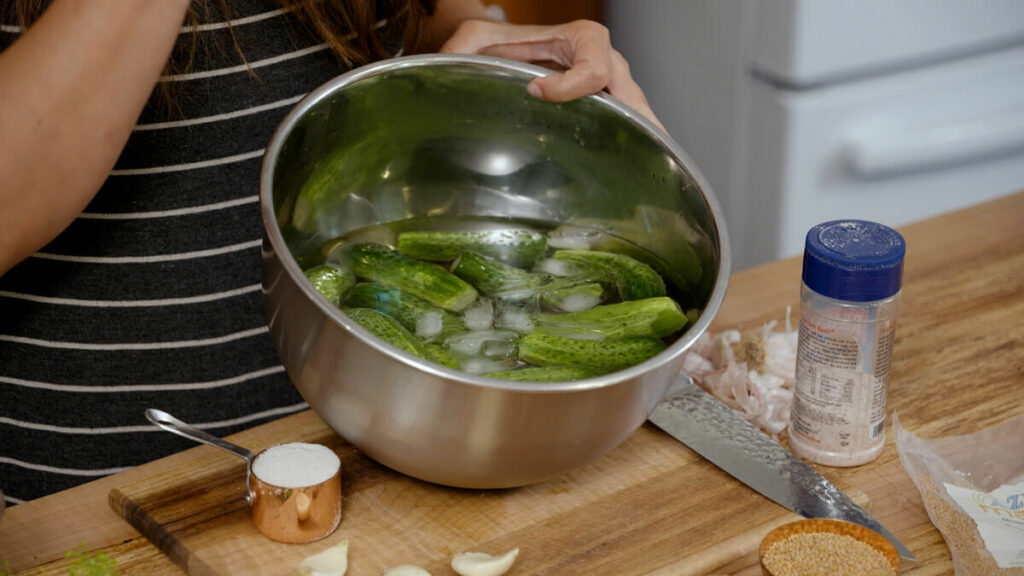
Step 1: Harvest cucumbers, wash well and cut off the blossom end. Then, place in a large bowl of ice water.
Pro Tip: You can leave cucumbers in an ice water bath in the refrigerator for a couple of days until you have enough for a batch of pickles.
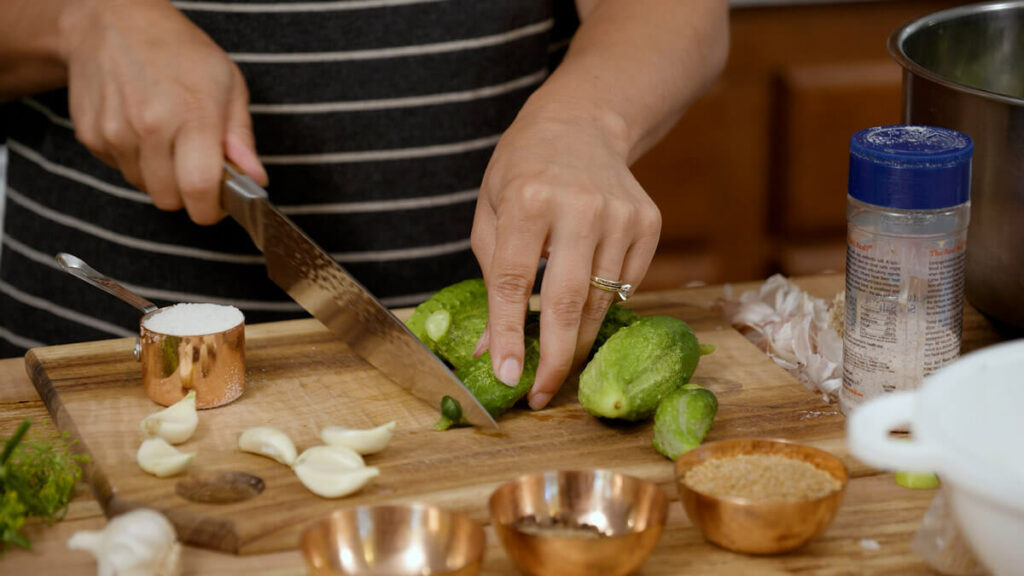
Step 2: When ready to make bread and butter pickles, remove cucumbers from the refrigerator and slice them up along with your peppers and onions.
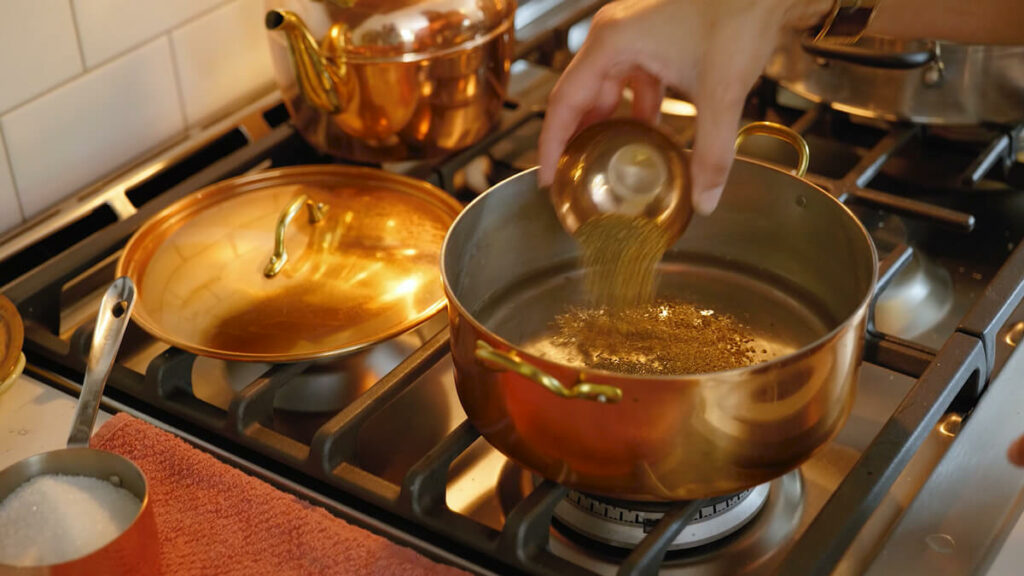
Step 3: Meanwhile, combine vinegar, sugar and spices into a large pot and bring to a boil over medium-high heat.
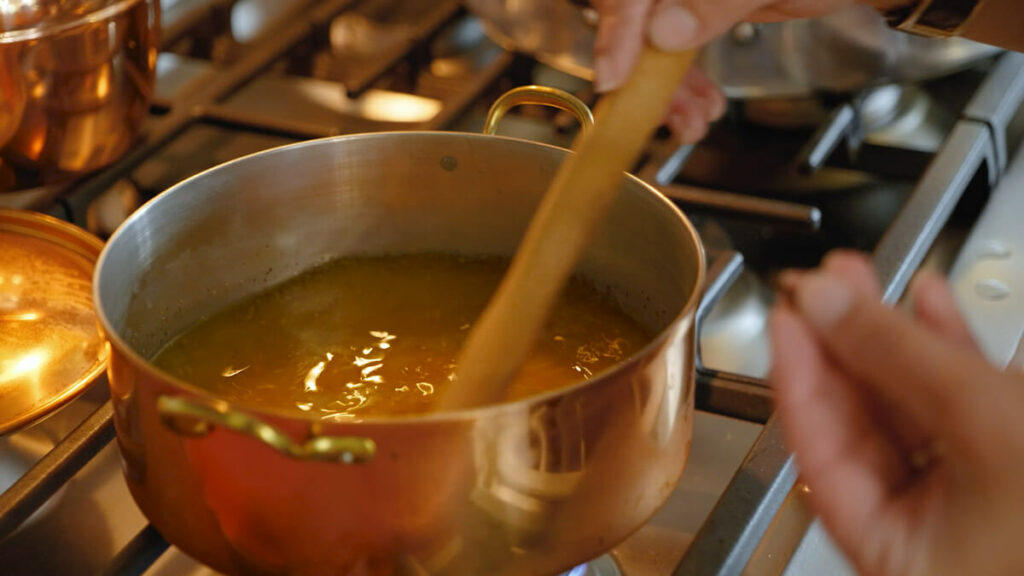
Step 4: Boil for three minutes, stirring occasionally, until all ingredients are combined and dissolved.

Step 5: Layer the vegetables in a clean mason jar (thinly sliced cucumbers, peppers, and onions). Push down lightly to pack vegetables down, leaving 1/2 inch headspace.
Place the jar on a towel folded in thirds on the counter.
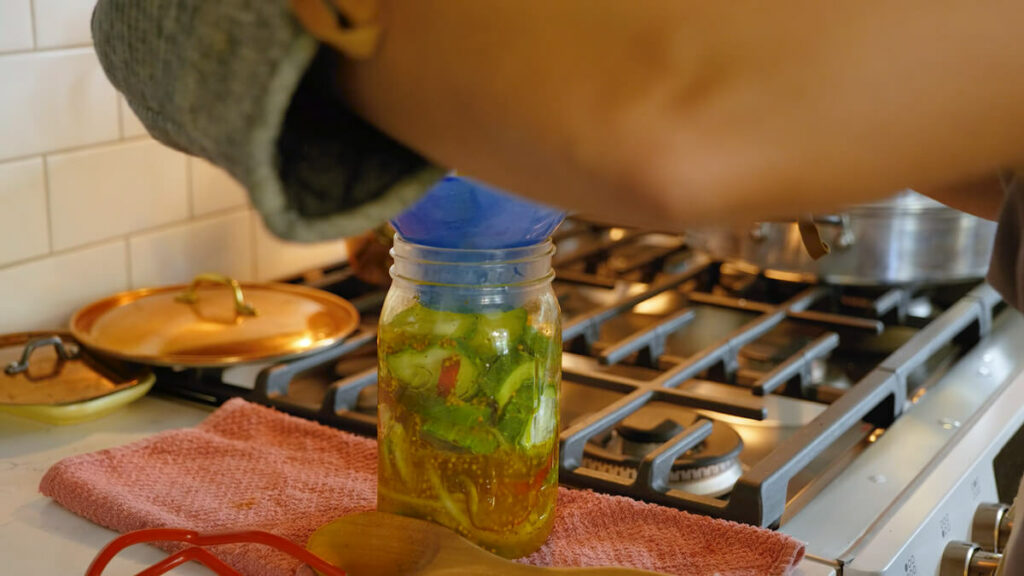
Step 6: Using a canning funnel and a ladle, pour the pickling liquid over the vegetables. You may have a slight amount left over, depending on how tightly you packed your jar.
Pro Tip – Store any remaining brine in the refrigerator for your next batch!
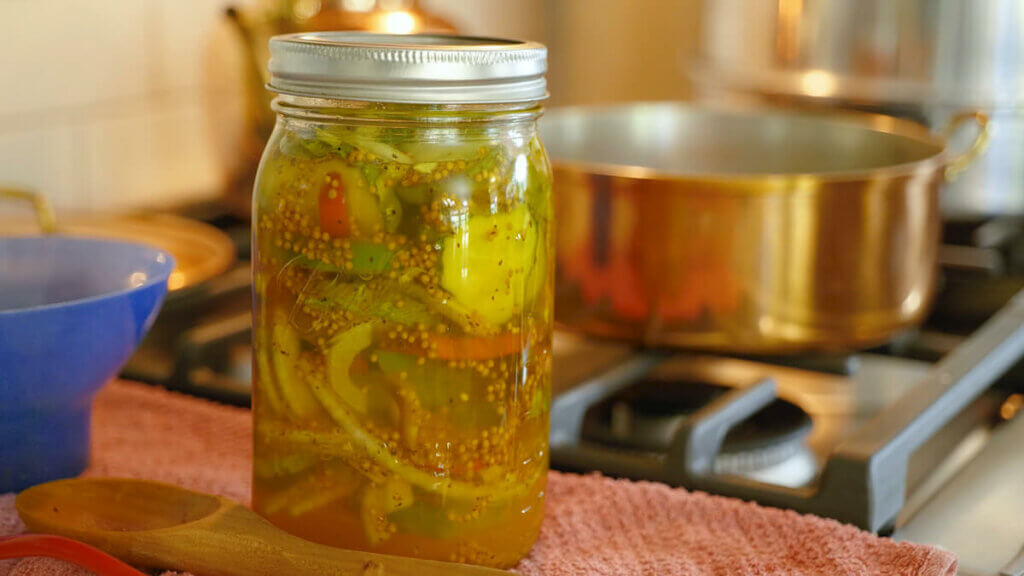
Step 7: Wipe the rim and apply a lid and band. Allow to cool to room temperature for about 30 minutes and place in the refrigerator.

Step 8: Test pickles after two weeks (if you can wait that long!).
Pro Tip – Pickles are just fine to eat as soon as you’d like (I usually snag my first taste-test after two days), but flavors will continue to get better and better.
Pickles should be consumed within three months.
How to Can Pickles
If you’d like to can this recipe, you simply need a hot water bath (or steam) canner and some canning tools. Pro Tip: If you don’t have a canner, you can use a large pot. Just be sure the water is able to cover the jars by one to two inches.
Step 9: While you’re packing your jars with the bread and butter pickles, prepare your water bath canner by filling it 2/3 full of water and bringing it to a low simmer on the stove.
Step 10: When you’re ready to start canning, bring the water to a boil and place canning jars into the canner carefully.
Step 11: Once all jars are in, bring the water back to a boil and boil for 10 minutes. (Check the altitude adjustment chart below if you’re 1,000 ft above sea level for total time.)
Step 12: When time is up, remove each jar from the water bath and place it on a towel-lined counter.
Let cool for 12-24 hours. Remove rings to ensure a good seal. Wipe jars, if needed, label and date and then store in the pantry for up to one year.
| Feet Above Sea Level | Increase in Processing Time |
| 1,001-3,000 ft | 5 minutes (Total of 15 minutes) |
| 3,001-6,000 ft | 10 minutes (Total of 20 minutes) |
| 6,001-8,000 ft | 15 minutes (Total of 25 minutes) |
| 8,001-10,000 ft | 20 minutes (Total of 30 minutes) |
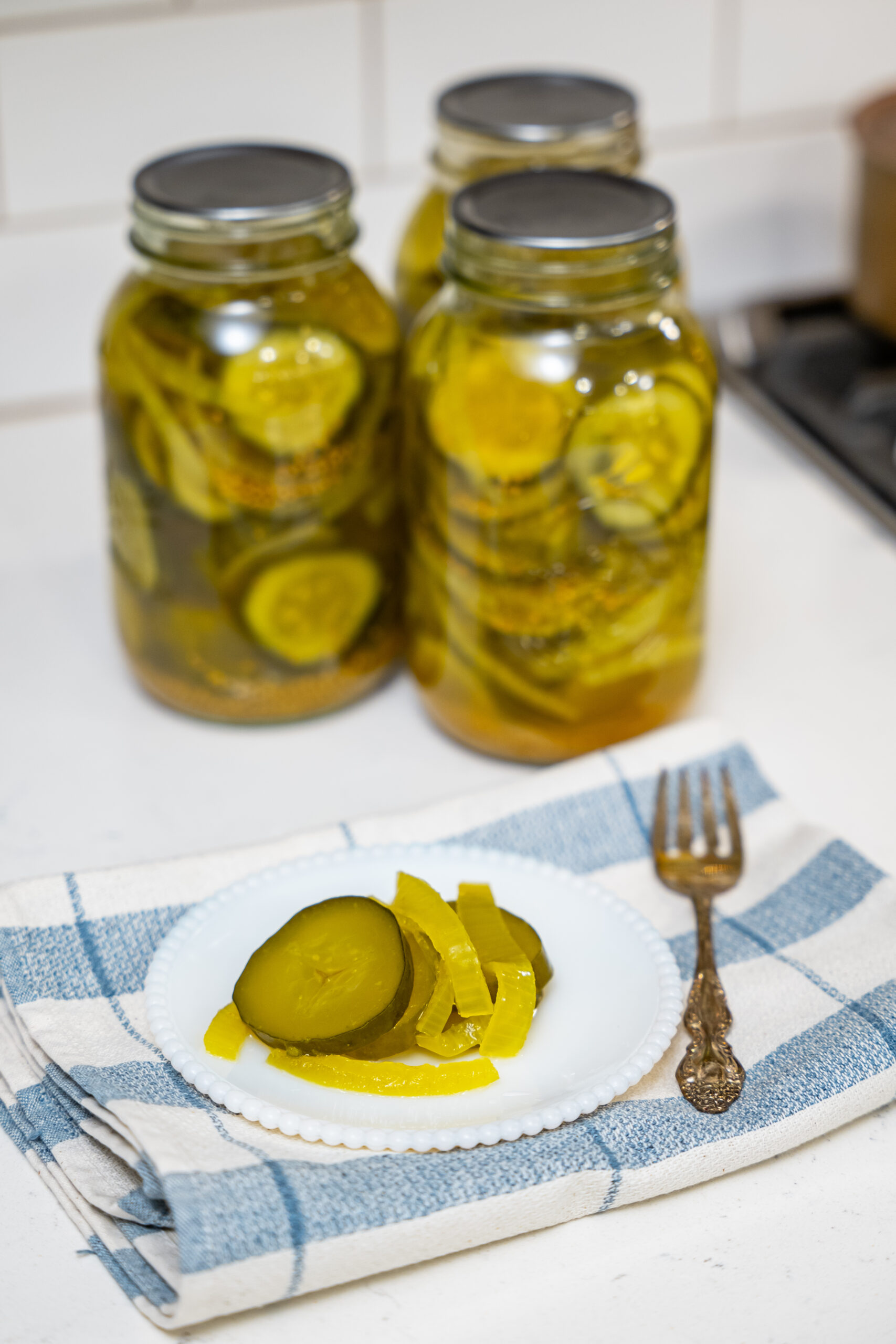
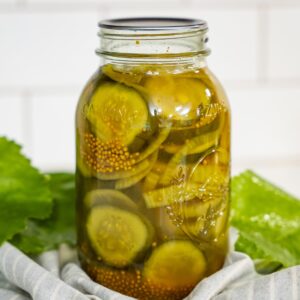
Refrigerator Bread And Butter Pickles Recipe (+ Canning Instructions)
Equipment
- 1 Quart Mason Jar or two pint-sized Mason jars
- 1 Large Pot
- 1 funnel
- 1 Ladle
Ingredients
- 2 cups pickling cucumbers trimmed and sliced
- 1/2 cup onion sliced
- 1/2 cup peppers sliced
- 2 cups white vinegar
- 2/3 cup sugar
- 1 tablespoon mustard seed
- 1 1/2 teaspoon celery seed
- 3/4 teaspoon turmeric
- 2 whole cloves
- 2 teaspoons salt
Instructions
For Refrigerator Pickles
- Sterilize quart-size mason jars and lids. Wide mouth jars work best when stuffing them for pickles, but the regular mouth will work as well.
- In a stainless steel saucepan, combine vinegar, sugar, salt, and spices. Bring the pickle brine to a boil at medium-high heat and boil for 5 minutes.
- Meanwhile, rinse the peppers, cucumbers, and onions. Cut off the blossom end of the cucumber and slice evenly. Cut up all the rest of your vegetables and place them in a large bowl.
- Layer the vegetables in the clean mason jar – thinly sliced cucumbers, peppers, and onions. Push down lightly to pack vegetables down and get a few more in. Allow 1/2″ headspace at the top of the jar. Place the jar on a towel folded in thirds.
- Using a canning funnel and a ladle, pour the pickling liquid over the vegetables. You may have a slight amount left over, depending on how tightly you packed your jar.
- Wipe the rim and apply the lid.
- Allow to cool to room temperature for 30 minutes and then place in the refrigerator.
- Pickles should marinate for two weeks and be used within three months. Confession: I always taste-test mine after two days and usually end up eating them all well before the two-week mark! But know the flavor will intensify over time.
To Can Pickles
- Follow the instructions above and while you're packing your jars with the bread and butter pickles, prepare your water bath canner by filling it 2/3 full of water and bringing it to a low simmer on the stove.
- When you’re ready to start canning, bring the water to a boil and place canning jars into the canner carefully.
- Once all jars are in, bring the water back to a boil and boil for 10 minutes. (Check the altitude adjustment chart below if you’re 1,000 ft above sea level for total time.)
- When time is up, remove each jar from the water bath and place it on a towel-lined counter.
- Let cool for 12-24 hours. Remove rings to ensure a good seal. Wipe jars, if needed, label and date and then store in the pantry for up to one year.
Notes
- Nutrition facts are calculated for an entire jar of pickles, minus the vinegar and spices.
- Pickles should marinate for two weeks and be used within three months. Confession: I always taste-test mine after two days and usually end up eating them all well before the two-week mark! But know the flavor will intensify over time.
- Be sure to cut the blossom end off the cucumbers, it contains an enzyme that softens pickles (and no one likes mushy pickles!).
| Feet Above Sea Level | Increase in Processing Time |
| 1,001-3,000 ft | 5 minutes (Total of 15 minutes) |
| 3,001-6,000 ft | 10 minutes (Total of 20 minutes) |
| 6,001-8,000 ft | 15 minutes (Total of 25 minutes) |
| 8,001-10,000 ft | 20 minutes (Total of 30 minutes) |
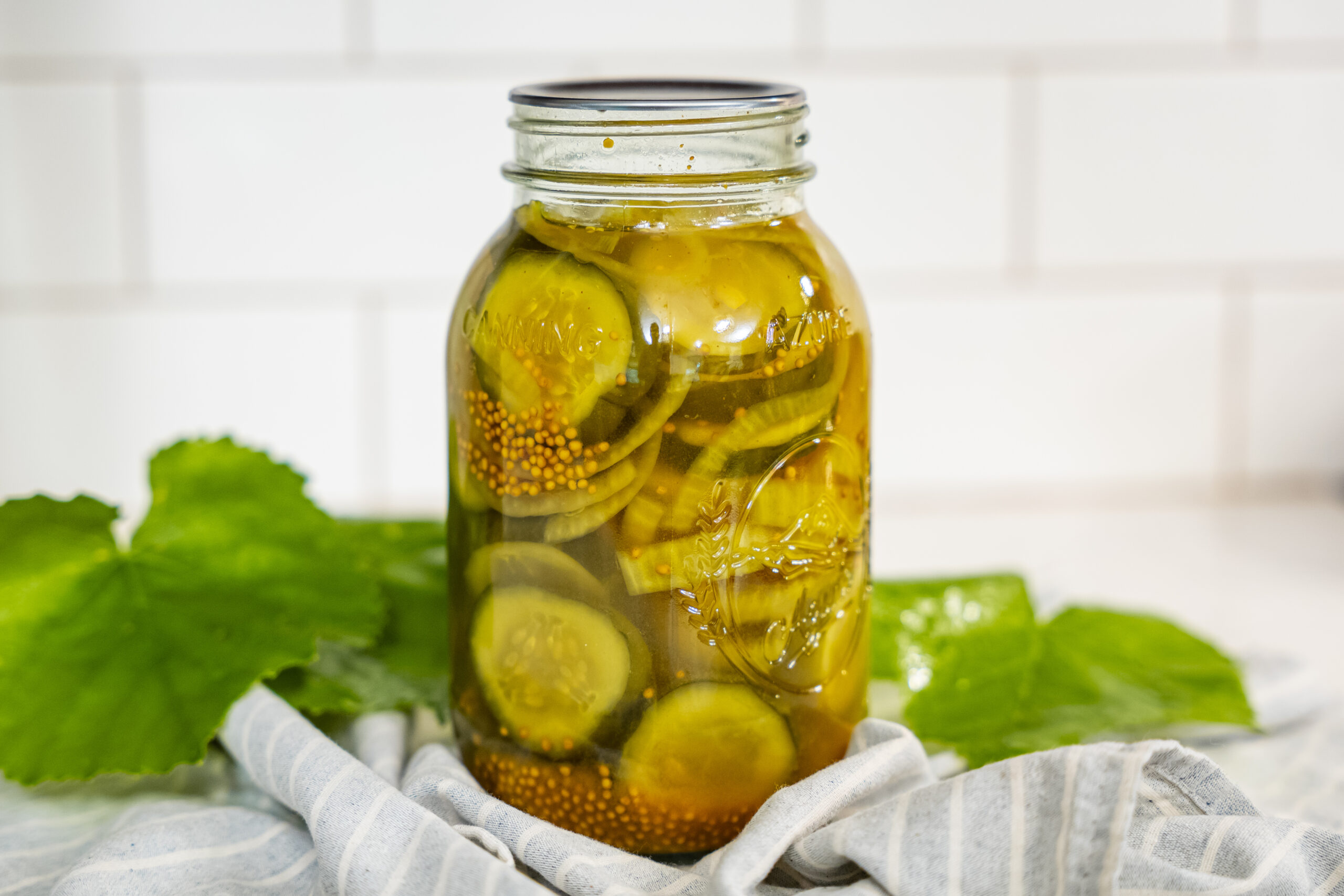
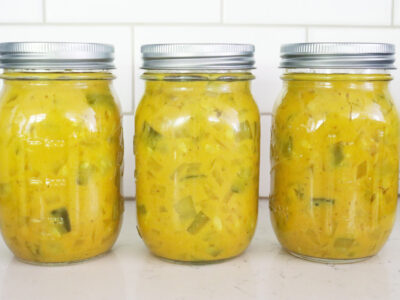

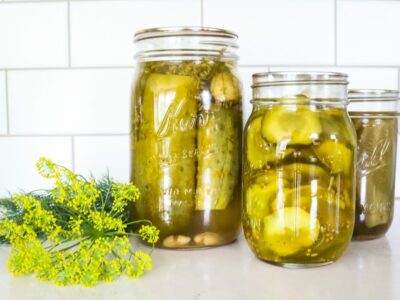
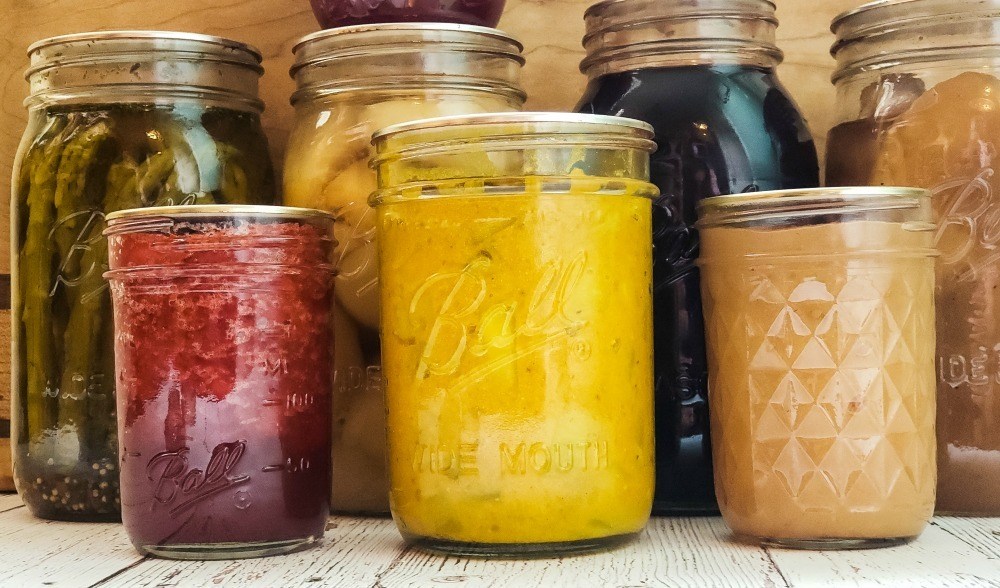
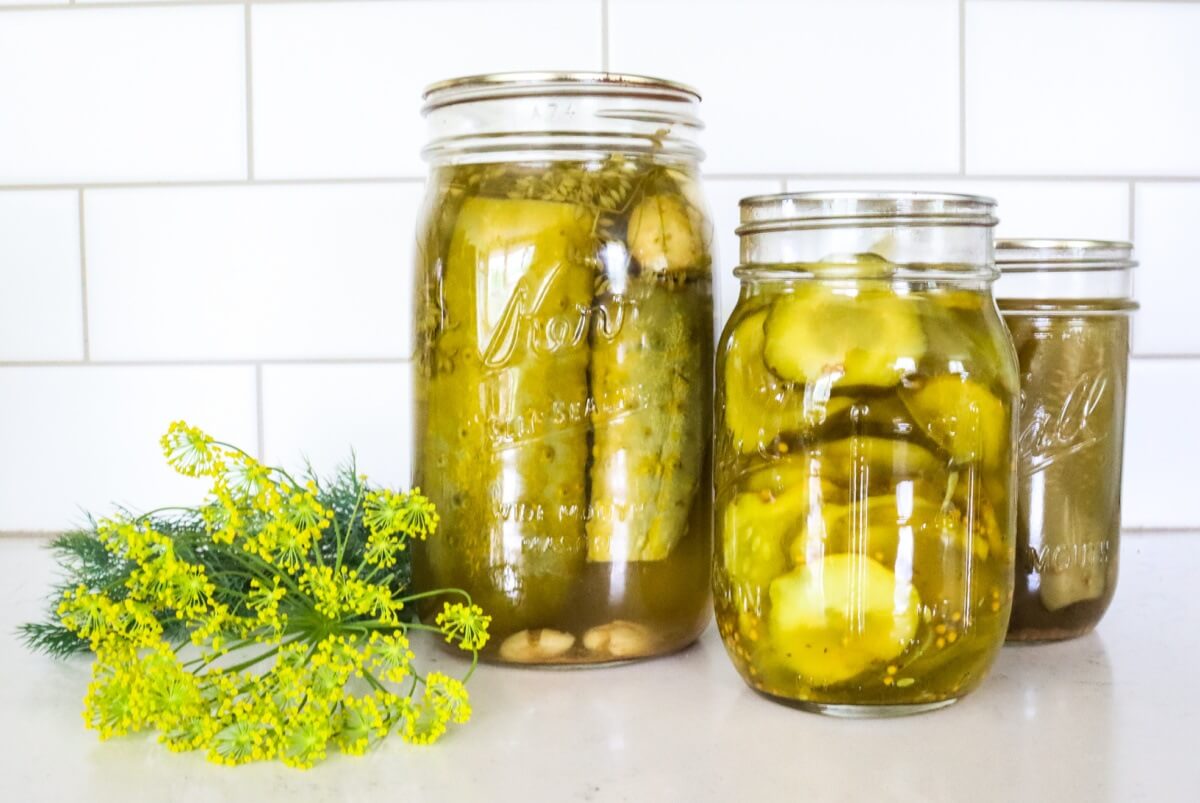

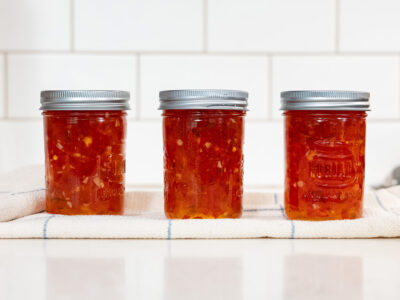
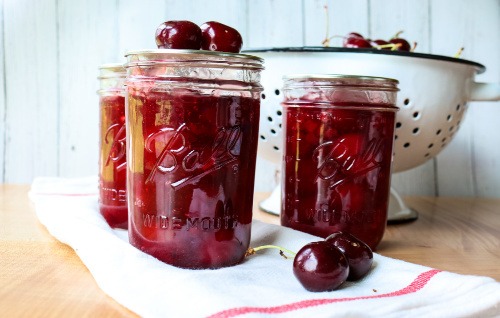

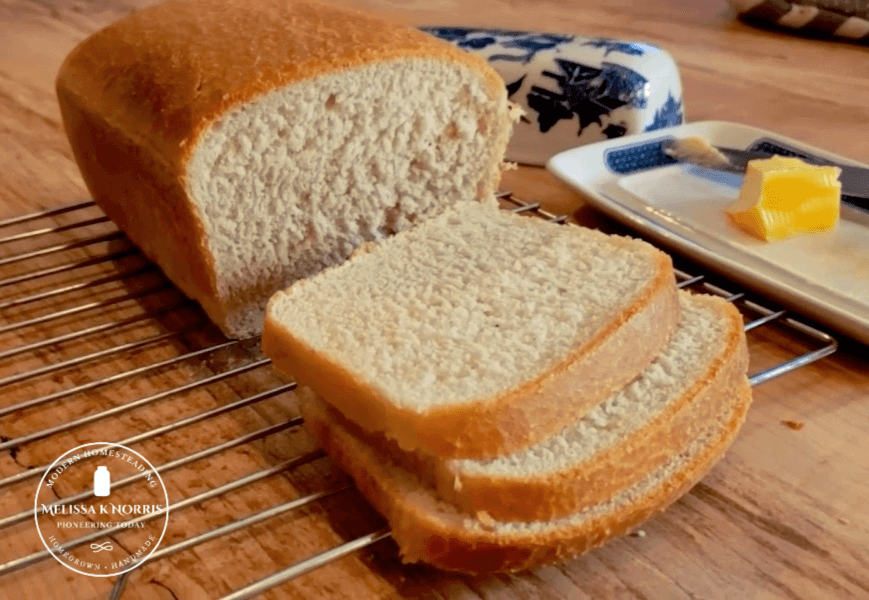
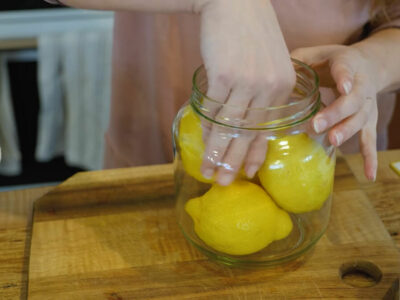


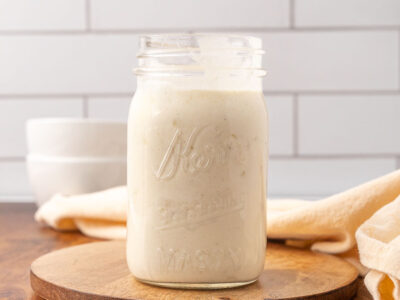
I love bread and butter pickles but can’t have the sugar. What sugar would work best for a substitute for sugar free pickles? Preferably one with no aftertaste.
Asking the same. I might honey or agave out. Or monk fruit.
I’ve not tried it with any of those sweeteners
Hi Melissa,
Pickle recipe is absolutely amazing! Quick question, can you water bath can these?
Nevermind Melissa, I see that you already answered this question. “Leave 1/2″ headspace and can for 10 minutes.” Thanks!
Can I use raw cane sugar in this and other canning recipes?
Yes
This recipe is wonderful ?
A hint for ‘stretching’ the amount of cucumbers you have on hand when making bread and butter pickles: I read somewhere online that radishes could be substituted for cucumbers.
In an effort to find out if that claim was true, one year my husband substituted thinly sliced radish for some of the cucumbers .
It did work – and worked very well in fact!!
(Sorry for passing on someone else’s tip without providing the credit for it, but the lady’s name escapes me at the moment.)
I believe it was a one-to-one substitution. And I think she said the substitution can be made as high as 50%. (Our exchange volume was not that much.)
There was no change in taste. No “sharpness” from the radish was apparent. The only evidence that there were radishes in the mixture was a pink coloration at the bottom of the bottle.
Sounds good, but what happens when there is no electricity? Anyone who wants food needs very long storage on a shelf, cellar, or buried in the backyard. I am preparing what I can, because grids are going down globally.
There are lots of canning recipes on my site and I also shared that you may can these and I’ve got tutorials on root cellaring, freeze drying and dehydrating food for long shelf life.
Melissa, do you have instructions on how to water bath can over a grill -or on a wood stove or fire pit with a grate? Thanks for a wonderful recipe.
The water has to be at a constant boil the entire time, regardless of heat source, there’s no change on the recipe
Is there a sugar substitute? I’m diabetic and this has too many carbs.
Thanks
I wonder if Melissa has info on no using any sugar for the canning process but rather adding stevia or monk fruit either in the recipe or upon opening the jar.
* PLEASE.do NOT use ERYTHRITOL artificial sweetener ( it can be an ingredient in other sweeteners -stevia & monk fruit & now in Allulose – read the label). It can cause cardiac events. Google it on pubmed.
Here’s the article https://pubmed.ncbi.nlm.nih.gov/?term=ERYTHRITOL The artificial sweetener erythritol and cardiovascular event risk.
Great pickles!
Do you have a similar recipe for dill pickles?
We make these every year and call them “Refrigerator Pickles” or Ice Box Pickles. My recipe is about 30 years old… and uses apple cider vinegar and the brine is not heated.
Could you can these up instead of refrigerate them? They would be delish to enjoy in the winter months.
Yes, use a 1/2 inch headspace and process via the hot water bath for 10 minutes.
Melissa, would we have to follow increased time tables for our elevation?
If you’re canning and your elevation is 1,001 feet above sea level you have to adjust processing times when water bath canning.
What kind of peppers did you use
Bell peppers
I love the recipe, I know I wanna TRY it! I shredded and sliced zucchini, hopefully it stays well in freezer. Will cucumber be good if i shred and slice it and put in freezer ?
I have overflowing okra in my garden. I like to eat it and no idea how to cook it. Can it be preserved? Dried? Frozen? Canned?
How much okra can I use in the pickles? I saute cucumbers and use in salad.
I enjoyed your class school of traditional school yesterday, keep up
Cucumber frozen and then thawed will be mushy so it depends on what you plan on using it in
Can mustard seeds be substituted for ground mustard?
Can refrigerator sweet pickles be canned instead? I usually male 20-30 quarts and it takes up a lot of space in the fridge.
Thanks!
I’d like the answer to this too!
What is blossom end of cucumber
Dave: There is a “stem” end (where the cuke was attached to the vine) and the “blossom” end (where the flower was). The stem end is usually bigger/wider & the blossom end would be the other end.
To be on the safe side I cut off both ends of the ? cucumber and I rub the ends of the cucumber with the ends I have cut off. It seems to eliminate the bitterness some cucumbers have. Good luck. Bread and Butter pickles are my favorite.
Do I have to put in the clove? I really dislike cloves (too much on Easter hams growing up) Thanks
No, you can leave them out if you don’t like the flavor, but they don’t come across very much (I’m not a huge clove fan either)
My guys prefer dill over sweet. Would I just leave out the sugar for this recipe?
Nicole,
Yes, feel free to leave out the sugar and up the dill!
Hey melissa will try the pickle recipe out sounds good am jealous of your garden bounty ours has been too hot to grow anything but weeds!!!! I have canned a few green beans and gotten onions and a few beets so far it has been pretty bad. Maybe fall will be different.
Try shade cloth. My neighbor has her garden on the side of her house covered with shade cloth. All except the corn. Her tomatoes were huge last year, mine burned, leaves curled and brown.
My favorite pickle is dill. Do you have a recipe like this for dill? Also, I do not have a garden, so if I purchase cucs at the store, will they not be crispy?
Betty,
I’d just cut out the sugar and add in some fresh dill. I usually do about 3 heads of fresh dill per jar of pickles myself. If you’re getting them at the store, look for pickling cucumbers and try to pick ones that don’t look bloated. You want the surface to be bumpy and prickly almost, not smooth.
Don’t forget yellow squash, zucchini, and okra make great bread and butter pickles as well. Of course you’ll have to wait on the okra. But, if you have just a few yellow squash, zucchini, or cucumbers, you can make the bread and butter pickles mentioned above. Try the yellow squash and zucchini, you’ll love it.
Thanks for the tip, Mickey. Unfortunately, I’m too cold for okra, but we’ll have lots of squash soon.
Hands down, bread and butter pickles are my favorite pickles! I put them on just about anything during the summer. We’ve even made tartar sauce with chopped up bread and butter pickles.
Love the thought of using these in tartar sauce, thanks Barb!
I can’t wait to try these! Unfortunately, I will probably have to wait until next year since we weren’t able to plant a garden this year. 🙁 Our house is on the market and we are moving from Louisiana (where I was born and raised) to live in Mississippi for my husband’s work. I am a little freaked out by all these changes but I do feel like we are being led there for a reason and I am trying to trust in that. If anyone wants to say a quick prayer for me, I would certainly appreciate it!
I have another pickle recipe that my neighbor gave me that she makes from a regular jar of dill pickles, for anyone who may not have a garden or easy access to pickling cucumbers. I haven’t tried them yet but I have tasted hers and they are wonderful!! More of a sweet-hot pickle. I’ll gladly send it along to anyone interested.
Gail, if you can find a good farmer’s market, I’d use their cukes instead of having to wait a whole year. Praying God guides you through this process and times and you come out trusting Him more than ever.
Gail, I would love to have the recipe you offered for the pickles using a regular jar of dill pickles. Thanks.
You are so kind to offer this recipe!! I can hardly wait to try it!! I’m just cutting up some cukes this evening for some mustard pickles. My family can’t live without them!! haha!! – Almost! I’ll let you know how I did!!! THANK YOU so very much!!! Hugs!!
A Happy Pickler!!
Rita
Love to have pickle recipe Thanks
Would love to have that recipe! Totally understand the change in venue. It’s always nice to have comfort food!!
Gail;
I would love to have your “sweet-hot pickle” recipe. (Pickling cucumbers seem to be scarce around these parts this year.)
Thank you,
Jane
Gail, my prayers are with you. No matter where you go, God will always be with you. You are never alone.
I would love to have your recipe for bread and butter pickles made from store bought dill pickles. (I don’t have a garden right now because my health has me unable to tend it.)
Thank you so much!
Would love your recipe for your hot dill pickles please ,,i know its been a while since this was posted but i just ran up on it,, thank you !
This pickle recipe sounds good! I want to try it out! THANKS for a great website!
Hi Melissa;
Renewed my subscription to your web-site and am so happy about it.
Used part of your recipe for red currant jelly; ; only had 31/2 cups of our own that had ripened recently and found that after mashing the berries, I measured the juice with equal amounts of sugar and lemon juice, of course, and I find that it was just too much sugar for the berries. I guess I prefer a bit more tartness in the jelly, but will change it for next year.
I love the colour of the jelly; it is just a beautiful and brilliant red. Can’t wait to share it with some of my friends! God is so good in His bounty. Praise His name.
May the Lord bless you and your family richly in all your endeavours.